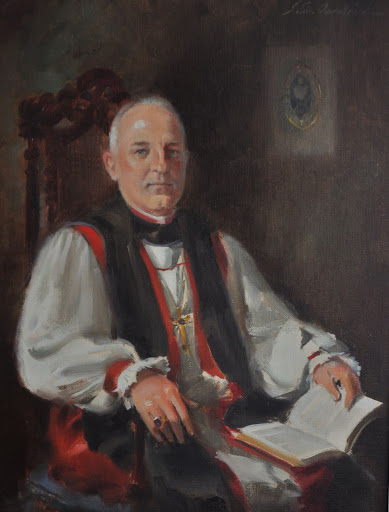In 1954 at the diocesan electing convention in St. Paul’s Church in Savannah, 17 candidates were on the ballot for Bishop of Georgia. The election was a decisive one as the Diocese elected the Very Rev. Albert Rhett Stuart, Dean of Christ Church Cathedral in New Orleans on the second ballot.
Born in 1906 in Washington, DC, Stuart grew up in Eastover, SC., son of a country doctor. He attended Episcopal High School in Alexandria, Virginia and graduated from University of Virginia in 1928, and Virginia Theological Seminary in 1931. Ordained priest at Church of the Resurrection, Greenwood in the Diocese of Upper South Carolina by Bishop K. G. Finlay. He became rector of this parish, leaving in 1936 to become rector of St. Michael’s Church in Charleston. In 1945, Stuart married Isabella C. Alston. They would have two children, Garden and Isabelle. He served as chaplain in the US Navy during World War II from 1942 to 1947 and returned to become the Cathedral Dean in New Orleans.
 Bishop Stuart and his family lived in the episcopal residence on Victory Drive and Reynolds Street in Savannah. The diocesan office at that time was in the basement of Christ Church in Savannah; the sole full time employee Olwyn Morgan, a native of Wales. Bishop Stuart moved the offices to 611 East Bay Street, which allowed for additional staff and a chapel. The bishop’s wife, Isabella, died in an automobile accident in South Carolina enroute to their vacation cottage. She was, of course, much mourned by the Diocese, as well as by Bishop Stuart and his family.
Bishop Stuart and his family lived in the episcopal residence on Victory Drive and Reynolds Street in Savannah. The diocesan office at that time was in the basement of Christ Church in Savannah; the sole full time employee Olwyn Morgan, a native of Wales. Bishop Stuart moved the offices to 611 East Bay Street, which allowed for additional staff and a chapel. The bishop’s wife, Isabella, died in an automobile accident in South Carolina enroute to their vacation cottage. She was, of course, much mourned by the Diocese, as well as by Bishop Stuart and his family.
In his 1962 convention address, after announcing the largest number of confirmations in the history of the diocese during the prior year, 819 persons, Bishop Stuart noted: “This is a gratifying achievement, but I must point out that it is below the normal growth rate of 10% of our communicants. If your congregation did not present for confirmation 10% of your communicant strength during the year, it is apparent that the members of your congregation are shifting their evangelistic responsibility to the clergy. The instruction for Confirmation in the Diocese should emphasize that each person presenting will himself be expected to present one other person for confirmation within the year.”
 Bishop Stuart always dressed in black vest and white shirt with French cuffs. Bishop Harry Shipps wrote of Stuart that he was, “The epitome of a Southern gentleman, he had impeccable credentials, strong leadership skills, and innate wisdom, all of which served him well as the storm clouds of racial unrest appeared over the South.”
Bishop Stuart always dressed in black vest and white shirt with French cuffs. Bishop Harry Shipps wrote of Stuart that he was, “The epitome of a Southern gentleman, he had impeccable credentials, strong leadership skills, and innate wisdom, all of which served him well as the storm clouds of racial unrest appeared over the South.”
Henry Louttit, recalls in his booklet, Saints of the Diocese of Georgia how Bishop Stuart was often the only white voice for integration in Savannah willing to speak on TV. He remembers him speaking up for welcoming groups seeking to integrate churches, “This is a free country. You can belong to any kind of church you wish, but the Episcopal Church has never asked anyone why they were coming to the church. We are not starting asking people now. This church is open to anyone who wishes to worship.”
When Bishop Stuart was consecrated in 1954, there were 8,904 communicants in the Episcopal Diocese of Georgia. He served as diocesan bishop through 1971, by which time the diocese had grown to 12,180 communicants.
Pictured: Bishop Stuart’s official portrait (top) and (below) Bishop Stuart is pictured with his secretary Olwyn Morgan in his office at 611 East Bay Street in Savannah.
